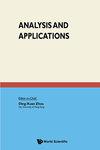广义调制空间的Gabor帧特征
IF 2.4
2区 数学
Q1 MATHEMATICS
引用次数: 2
摘要
我们获得了通过最近在[10]中引入的一类平移调制不变分布Banach空间定义的调制空间的Gabor框架特征。我们证明了这些空间允许通过Gabor展开进行原子分解,并且它们的特征是它们的Gabor系数的可和性。此外,我们构造了一个大的可容许窗口空间。这概括了经典调制空间Mw的几个基本结果。由于在定义这些调制空间的Banach空间上缺乏坚固性假设,用于空间Mw(或者更一般地说,在共轨空间理论中)的方法在我们的设置中失败了,我们在这里开发了一种基于扭曲卷积的新方法。本文章由计算机程序翻译,如有差异,请以英文原文为准。
Gabor frame characterisations of generalised modulation spaces
We obtain Gabor frame characterisations of modulation spaces defined via a class of translation-modulation invariant Banach spaces of distributions that was recently introduced in [10]. We show that these spaces admit an atomic decomposition through Gabor expansions and that they are characterised by summability properties of their Gabor coefficients. Furthermore, we construct a large space of admissible windows. This generalises several fundamental results for the classical modulation spacesM w . Due to the absence of solidity assumptions on the Banach spaces defining these modulation spaces, the methods used for the spaces M w (or, more generally, in coorbit space theory) fail in our setting and we develop here a new approach based on the twisted convolution.
求助全文
通过发布文献求助,成功后即可免费获取论文全文。
去求助
来源期刊
CiteScore
3.90
自引率
4.50%
发文量
29
审稿时长
>12 weeks
期刊介绍:
Analysis and Applications publishes high quality mathematical papers that treat those parts of analysis which have direct or potential applications to the physical and biological sciences and engineering. Some of the topics from analysis include approximation theory, asymptotic analysis, calculus of variations, integral equations, integral transforms, ordinary and partial differential equations, delay differential equations, and perturbation methods. The primary aim of the journal is to encourage the development of new techniques and results in applied analysis.

 求助内容:
求助内容: 应助结果提醒方式:
应助结果提醒方式:


